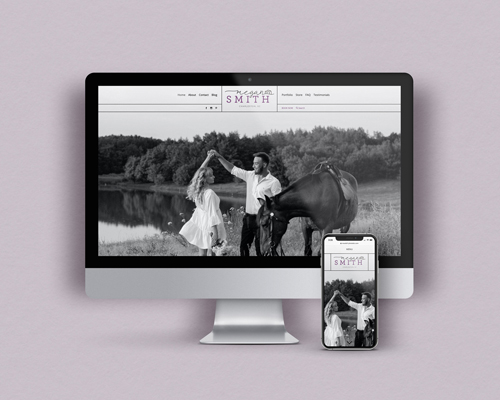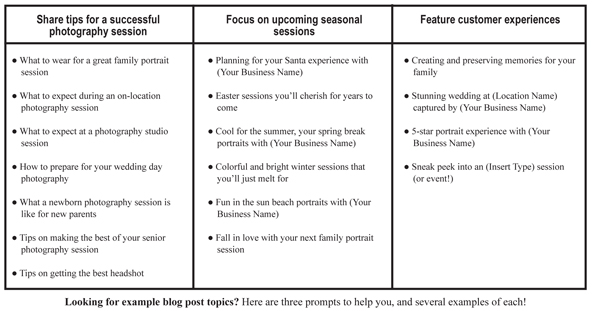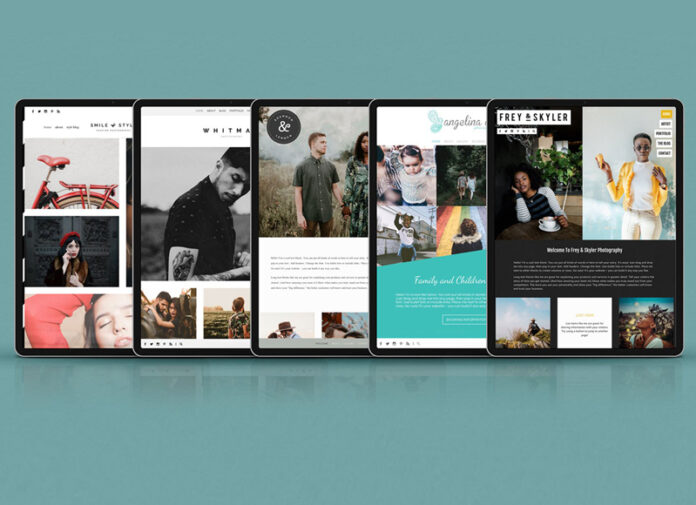In the Social Age of Business, You Need More Than Just Image Galleries
By Jeremy Hyler
Creative Director, PhotoBiz
Getting your business online is more important than it has ever been. With more and more people turning to creative businesses like photography, competition is everywhere. Everyone is looking for some secret sauce to make themselves stand out. Businesses compete for search engine rankings and to capture attention on social media. Promoting your business can start to feel like a job itself. Not only are you a photographer and business owner, but you are also the marketing team.
There are a lot of options and it can be a lot of work. In the last 15 years, the rise of social media platforms like Facebook and Instagram, provided new ways to connect to friends and family. It’s nearly as revolutionary as the telephone itself. You’re able to interact with people, create business pages, and share content as fast as you like. Social media became the way many people would drive business and some even use it as their only source of online promotion. But social media has limitations.
You may have heard of the world algorithm, in phrases like “Instagram has changed its algorithm.” It refers to how the platform prioritizes what content you see (or do not see). The algorithms for social media tools like Instagram and Facebook continue to change and unfortunately, not all of your followers will see your posts.
Relying purely on social media to promote your business online is not a safe bet. Social media should be paired with a website. Social media should not be your website. A website gives you control over what customers see, and the information you want to share. Your social media posts should drive people to your website to learn more.
With social media, you compete with memes, videos, and other users. Your posts are just a flick away from being forgotten. You need to have more control, more stability, and more creative freedom. You need a website! Having a website is crucial to running a business. Let’s talk about how you can use a website as a sales tool, to fight for visibility, to humanize your brand, and to connect with social media users.
What’s changed with websites – A website is never “done.” You need to update it, keep it current, and add fresh content to show that your business is active. There was a time when as a photographer, all you needed to do to have a website was to drop pictures into an online gallery, write an about page, and set up a contact page. If you did that, you could call it a day. You can’t really do that anymore. Particularly, if you want to be found on Google or other search engines. You need more than images on your website and you need to update it with fresh content.

Words on your website matter, particularly organically written words. Say what? Search engines are getting smarter. They look at so much more than a website’s metadata. They “read” the content on the pages of your website. And they evaluate it. Google’s AI searches for content-rich pages that will be engaging to users. Websites stuffed with keywords or not enough content get penalized.
Google is learning how humans talk. And they are considering how real or organic website content is when considering how to rank websites. When a website has engaging well-written content, Google rewards that and says, “This is worth sharing with others.”
Core Pages (what to focus on first) – As a photographer, when you work on your website it is easy to get caught up in the visuals, and brush the content aside. But you have to think beyond your pictures, beyond your photo galleries. There are three core pages on your website you should focus on first. These pages include your Home, About, and Contact pages. These pages are your most valuable for a few reasons:
The Home Page acts as your brochure or elevator pitch. It’s where you tell visitors the who, what, when, where, and why of your business. You should show off your amazing images, highlight some testimonials, and include a way for people to contact you, such as a form. It should also engage visitors and encourage them to explore pages deeper in your site. Buttons or Call-to-Actions (CTAs) can help.
See Jeremey Hyler Live at the IHEART PHOTOGRAPHY CONFERENCE AND EXPO in Grapevine, October 14-16, 2022
The About Page is what I call “the speed dating page.” This is where a visitor learns about you and possibly meets you for the first time. It’s a place for you to add a personalized photo of yourself so people can see how they could do business with. You should also talk about your history with photography, your approach, your accomplishments, and include a few personal anecdotes to make you approachable and relatable. The About page is where you get to tell potential customers why you are a photographer, and why they should work with you.
The Contact Page is just that, a page where visitors can connect with you. Best practice is to have a form on this page that people can complete to send you a message and you can collect information. It is also a great place to feature your phone number..If you have a physical location people can visit. It is also a good idea to include your address, a map, and hours of operation on your Contact page. You’d be surprised how many websites we’ve seen that don’t have a Contact page. It is an important tool to make it simple for current and potential clients to contact you.
Yes you should also have gallery pages, testimonials, and more content on your website but it is key to get these three core pages built first.
Blogging (but it doesn’t have to be hard) – Okay, time for a real conversation that most photographers fear … writing a blog. A blog is something you should really consider for your business. I know, I know. I’ve heard it all before: I don’t know what to write about, I don’t know how to write about myself, I’m afraid I’ll do it wrong … Writing can be difficult. Some people are better writers than others, but it doesn’t have to be hard and it is really helpful for search engine optimization.
A blog is a great tool to add fresh content to your website about a variety of topics related to your business. Blogging can be particularly helpful for search engine optimization. By producing quality, content-rich, and engaging content, you are feeding content to search engines like Google.
Blogging is great because:
● Provides freshly created content for your followers on a regular basis
● Engages visitors to learn more about your business
● Serves as content to share on social media, that is not just your portfolio of images
● Offers search engines new activity on your website to help push those pages up in ranking
So how much should you write and how often? You don’t have to write that much, I promise. A good goal is 300-500 words per blog post, just a few paragraphs can really help. Start by brainstorming topics for your blog posts. As you do this, consider what keywords you can naturally include without sounding like you are playing a game in which you have to use these 10 words in a sentence. A few paragraphs of text, plus a few images (not a whole session), and a few CTAs to encourage visitors to engage with you further, and you have a recipe for success.
Blog posts can serve as long-lasting content that can continue to drive traffic and engagement. Yes! That’s right, blog posts can be posted on social media more than once to get the attention of your current customers and potential new ones.
Not everyone will see everything you post, so it can help to reshare blog posts or share them with a new angle. In fact, re-sharing content helps garner more engagement and drives more people to your website, which is your ultimate goal.
So remember, once you write a blog post, continue to share it! It is a resource to be revisited and shared, not a once-and-done activity.
As you make changes to your business, make sure to update or archive past blog posts so they reflect any changes you’ve made and you can continue sharing the posts. Google will reward you if more people come to your website, and stay or read your content.

Websites: Your Dedicated Sales Funnel -The most exciting part about having a website is control! You control the design, you control the flow, you control the content, you control the experience. This includes the sales process or sales funnel to guide people to make a purchase.
There are a variety of creative and strategic goal-oriented landing pages that are hot right now. You may hear them called sales funnels, click funnels, or StoryBrands. No matter the buzzword, they all can help you close sales.
Sales funnels – Sales funnels are the journey people take as they interact with your marketing promotions, ads, emails, and/or social media, on their way to make a purchase. You use these tools to drive people to landing pages, give them options to make a purchase, and then convert them into customers.
Click funnels – A click funnel is a series of landing pages, ads, or social media posts that lead people to a landing page for a free download, product, service, or event to subscribe to. They typically don’t have a monetary sales goal.
StoryBrand – A StoryBrand is a landing page or home page that identifies and solves a problem or presents an opportunity by telling an enriching story about how to solve that problem with the help of your services or products. You position yourself as the one who can solve the problem, illustrate how you can solve the problem, how you are different from competitors, and then close with a call to action (typically to make a purchase), plus share customer success stories.
You may notice, each of these involve landing pages or pages on your website. Every website is capable of being a sales funnel, click funnel, or StoryBrand. How you set up your website and landing pages, comes down to your goals. And it all comes back to the core question, what do you want your website to do?
Deciding what you want your site to do in terms of selling and upselling clients is really up to you. That’s one of the benefits of having a website. You get to tell your story, in your way. You get to control the messages your visitors, clients, or potential customers receive.
Key takeaways – A website is an important tool. It can help you get found online and provides a place to send people from your social media channels, email marketing campaigns, and more.
Quick tips on how to use your website:
● Make your website engaging, feature fresh content
● Make your website easy to read and keep it simple.
● Blog 1- 2 times each month and share those blog posts on social media and through email marketing campaigns
● Provide ways for visitors to interact with you on your website, think calls to action and forms
● Create a Google My Business page with your website address attached to it
● Add opportunities for people to contact and book with you
● Make your website’s navigation simple, feature 7-8 pages max in the menu
● Add organic content and metadata to each page of your website
● It’s digital so you can change it anytime!
As time goes by websites and digital marketing strategies will continue to change. You have to stay agile not only in creating your art, but also in promoting your business. Just breathe, and focus on what matters: your beautiful art and your relationships with your clients.
 Jeremy Hyler has worked in the film and video industry for over twelve years where he worked with brands like ESPN, DISCOVERY, FOX, DELTA, MASTERCARD as a videographer and editor. He found his passion was telling short form stories through marketing and helping businesses. Later, he pivoted into marketing and web design, something he has explored since he was a child. He has been helping photographers and small businesses as the Creative Director of PhotoBiz for over the last eight years. PhotoBiz offers a powerhouse platform with dedicated hosting and support to help photographers showcase their work. Learn more at PhotoBiz.com
Jeremy Hyler has worked in the film and video industry for over twelve years where he worked with brands like ESPN, DISCOVERY, FOX, DELTA, MASTERCARD as a videographer and editor. He found his passion was telling short form stories through marketing and helping businesses. Later, he pivoted into marketing and web design, something he has explored since he was a child. He has been helping photographers and small businesses as the Creative Director of PhotoBiz for over the last eight years. PhotoBiz offers a powerhouse platform with dedicated hosting and support to help photographers showcase their work. Learn more at PhotoBiz.com
See Jeremy Hyler LIVE at the iHeart Photography Conference and Expo in Grapevine, October 14-16, 2022.











